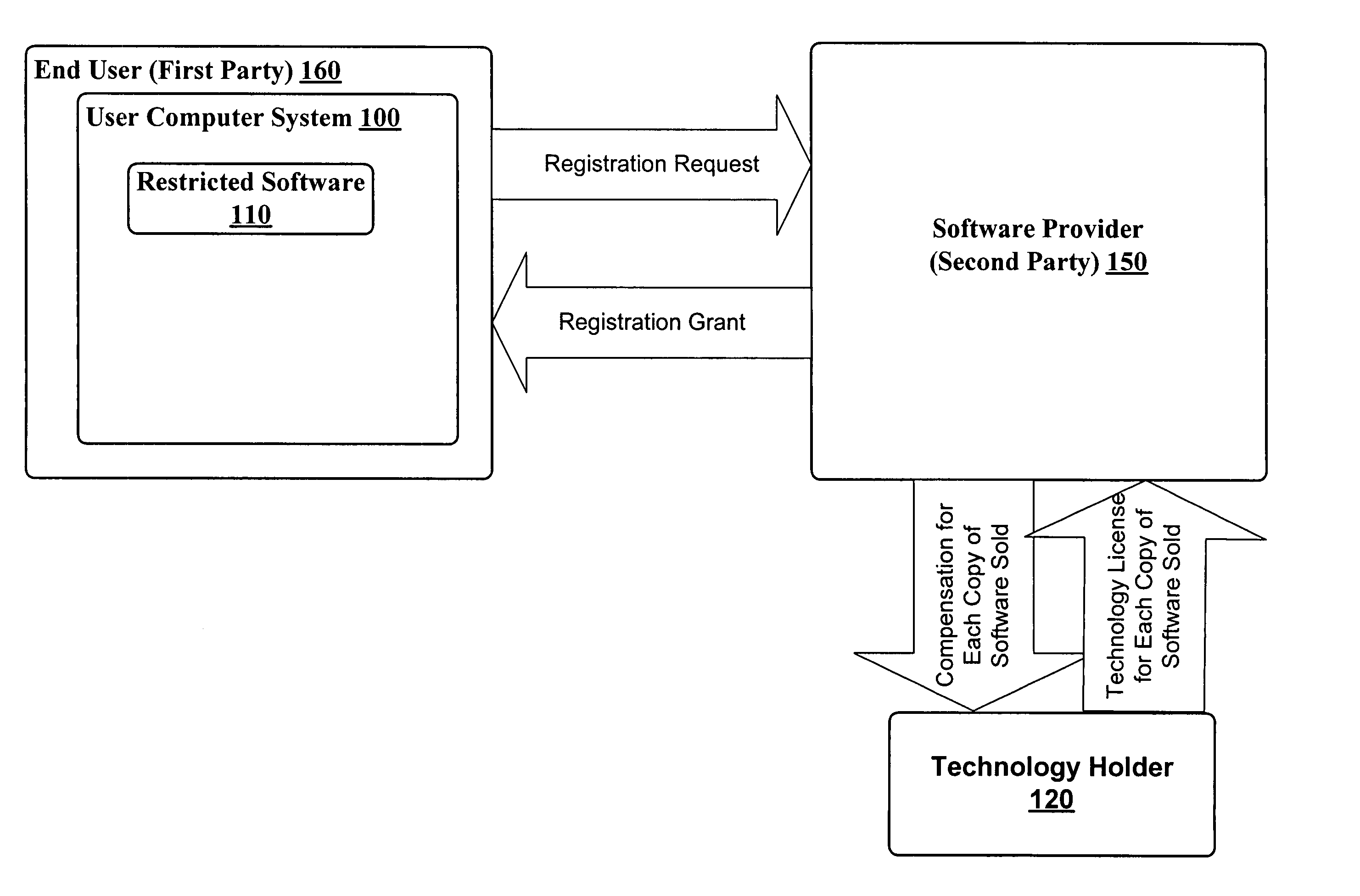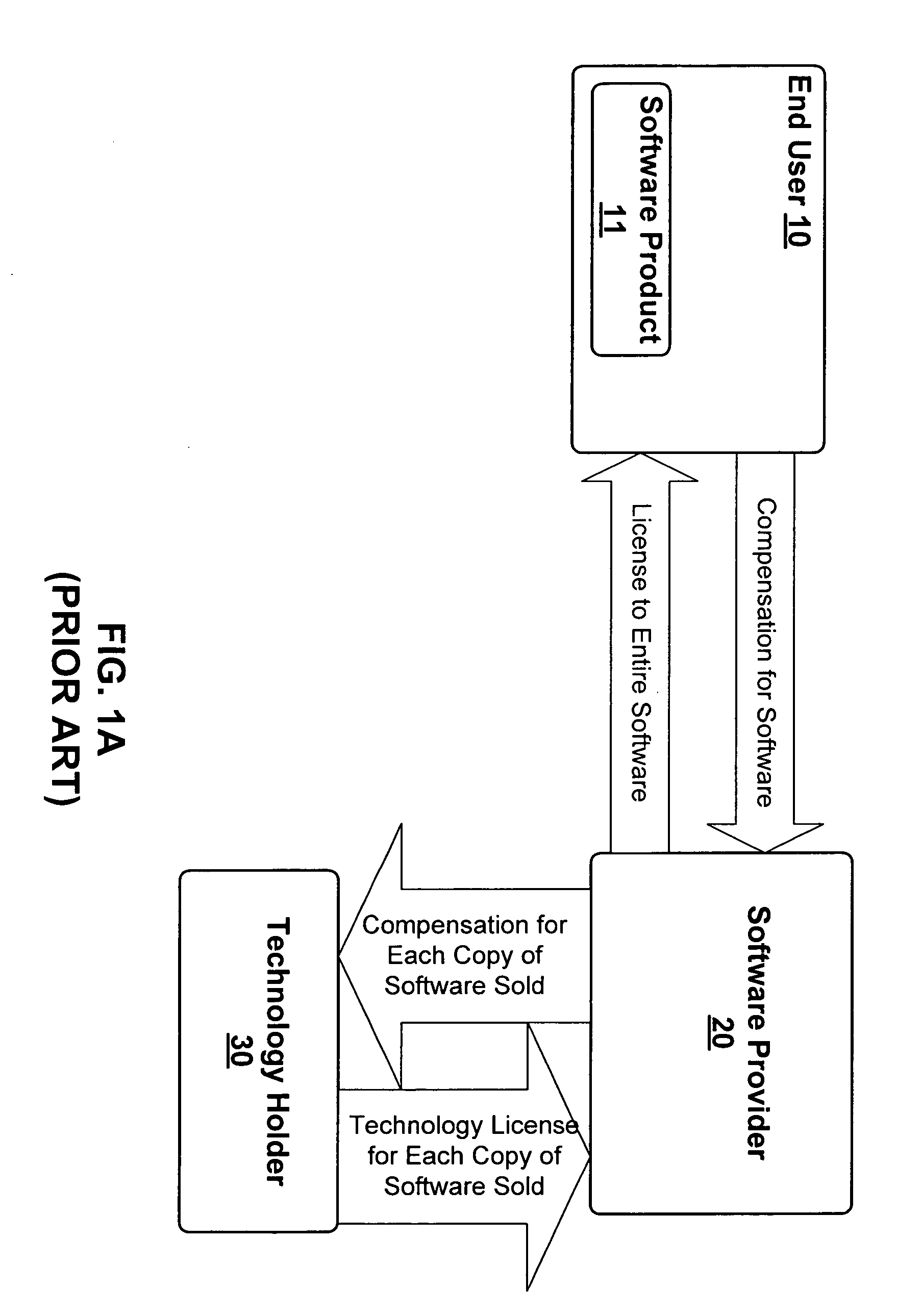System and method for licensing software
a software and licensing system technology, applied in the field of licensing systems and methods, can solve the problems of wasting license fees associated with technologies, software generally involves considerable per-unit licensing fees, and users may not use their dvd drives at all, so as to reduce costs, reduce costs, and clear understanding and documentation of the value of technology in the marketplace
- Summary
- Abstract
- Description
- Claims
- Application Information
AI Technical Summary
Benefits of technology
Problems solved by technology
Method used
Image
Examples
first embodiment
[0031]FIGS. 2A-2E depict an overview of several embodiments of the proposed efficient software licensing system. In accordance with the broader aspects of the system, FIG. 2A depicts a software licensing system including a first party (typically an end user 160), a second party (typically the software provider 150), and a technology holder 120. In such a system, the second party 150 pays the technology holder 120 for a license associated with each copy of a software product 110 sold containing technology owned by the technology holder 120. The first party 160 acquires software product 110, which is fully licensed, but contains unregistered software functionality. Thus, neither the first party 160 or the second party 150 are required to provide further compensation to the technology holder 120 for the software functionality used. However, despite the functionality being licensed, certain software functionality is disabled until the first party 160 requests registration of the functio...
second embodiment
[0032]FIG. 2B depicts the broader aspects of a second embodiment in which a third party (typically a hardware provider 170) provides the first party 160 with bundled software containing functionality restrictions. The bundled software is produced by the second party 150, and the software incorporates technology requiring a license from a fourth party (typically a technology holder 120). The first party 160 requests registration of the unregistered functionality with the second party 150. Upon receiving the registration request, the second party 150 records the registration and enables the newly registered software by delivering a relieving mechanism to the first party 160. Finally, the second party 150 compensates the fourth party 120 for a license to the actual technology used by the first party 160. Compared to FIG. 2A, the system of FIG. 2B provides compensation to the fourth party 120 only when an end user 160 registers technology owned by the fourth party 120.
third embodiment
[0033]FIG. 2C depicts the broader aspects of a third embodiment in which the third party 170 provides the first party 160 with bundled software 110 containing functionality restrictions. The bundled software 110 is produced by the second party 150, and the software 110 incorporates technology requiring a license from a fourth party 120. The first party 160 issues a request to register an unregistered function to the second party 150. Upon receiving the registration request, the second party 150 records the registration and enables the newly registered software by delivering a relieving mechanism to the first party 160. The second party 150 compensates the fourth party 120 for the actual technology used by the first party 160. Finally, the third party 170 compensates the second party 150 for the actual technology used by the first party 160.
PUM
 Login to View More
Login to View More Abstract
Description
Claims
Application Information
 Login to View More
Login to View More - R&D
- Intellectual Property
- Life Sciences
- Materials
- Tech Scout
- Unparalleled Data Quality
- Higher Quality Content
- 60% Fewer Hallucinations
Browse by: Latest US Patents, China's latest patents, Technical Efficacy Thesaurus, Application Domain, Technology Topic, Popular Technical Reports.
© 2025 PatSnap. All rights reserved.Legal|Privacy policy|Modern Slavery Act Transparency Statement|Sitemap|About US| Contact US: help@patsnap.com



